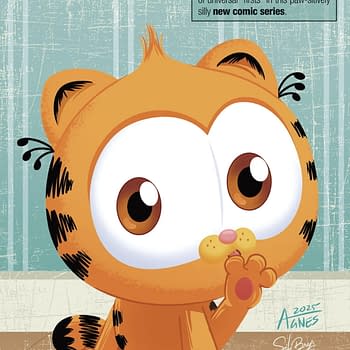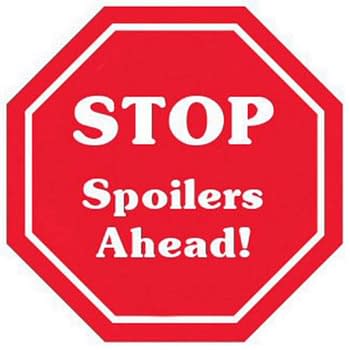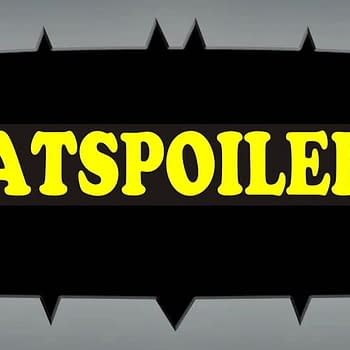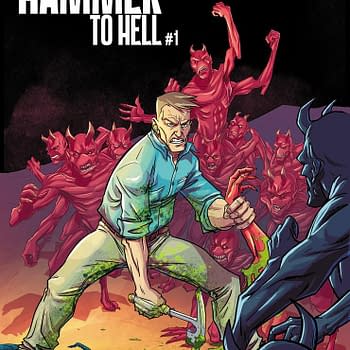Posted in: Comics | Tagged: Comics, dc, entertainment, green arrow, green lantern, neal adams
No Evil Shall Escape My Sight
Peter Stone writes,
Forty five years ago, there was a revolution in comics. Green Lantern/Green Arrow #76 hit the stands. It changed not only the way comic fans perceived the heroes, but it altered the sale of comics through the newsstands and heralded (years later of course) the Direct Sales market. Comic Conventions started to become more and more common. No longer were superheroes simply battling villains bent on taking over the world.
Denny O'Neil and Neal Adams' Green Lantern/Green Arrow series of 13 plus issues were so popular that it has never be unavailable in print. Hardcovers, softcovers, a six-issue reprint series, a Millennium edition…and a vast plethora of non-fiction books referencing the importance of Green Lantern #76 to Black Superheroes, Comic Book History, the Seventies and even Comic Books as literature.
DC Comics is releasing a Absolute Edition of the Green Lantern/Green Arrow run by Denny and Neal on the 29th of December this year and it's worth the wait. As a strange coincidence, Heritage Auctions has put up the original art of Green Lantern #76 for sale at the end of November. As one of the most important pieces of comic art (possibly ever), I thought it was a moment to look back and reread the series. The social importance, as well as the importance to the industry in general, is overwhelming not just as a moment in history, but also as a commentary about how much hasn't changed.
Green Lantern/Green Arrow #76 was a landmark issue for DC Comics. It featured the journalistically influenced writing of Denny O'Neil and the illustrative penciling talents of Neal Adams. Both men went on to pursue different directions and opportunities in their careers, but their Green Lantern/Green Arrow run remains a powerful and influential run of social commentary and how two opposing heroes deal with some of the problems facing our society.
For example, after Green Lantern #76, a story like the following might have appeared in the Star City newspapers the next day:
"In a rare triumph of justice for abused NYC renters, a Manhattan landlord named Jubal Slade, known for destroying their own properties to force out rent-stabilized tenants has been arrested.
"Manhattan District Attorney Jeremy Tine announced yesterday that the landlord has been indicted on a slew of charges including fraud, grand larceny, criminal mischief, falsifying business records and unlawful eviction.
"We simply will not allow the hardworking people of Brooklyn to be intimidated and harassed or have their apartments destroyed by those who seek to force them out just to make money from the lucrative real estate market," Tine said in a statement."*
It might have sparked a series of articles about slumlords and housing in New York City. Maybe headlines like this would appear:
"Anna Merlan went long this week to try and figure out what can be done about the "pernicious – and growing – New York real estate problem (of) landlords who deliberately make their own buildings unlivable, through vandalism, harassment, nuisance construction, legal intimidation and outright threats, as a way to drive out rent-stabilized tenants."
Perhaps tomorrow's headlines might have been, 102 Tenants Exposed to Insane Amounts of Lead Dust." Or "14 Arrested in Drug Bust at Housing Project. Maybe In New York, Rising Teen Drop-out and Incarceration Rates with the story focusing on the 65 percent of minority youth who drop out of school to support themselves or their families, a plot point in the early section of No Evil Shall Escape My Sight.
All of these stories seem like they could have been ripped right out of the pages of Green Lantern/Green Arrow #76 from 1970. Forty-five years ago. The real problem is – they're not. They're all stories about NYC today, this year. None of them have Green Lantern or Green Arrow in them, but the stories speak for themselves.
There were other stories along the way; political commentary concerning the President at the time, a story about pollution derived from plastics, a loose allusion to the Manson Cult, the plight of Native Americans and even a brief commentary about sexism. These were couched in plots with super villains and love stories, but there was a sense of sincerity to the series. Anyone who thought the pair had lost their steam and there was nothing left to be angry or upset about could not have been more wrong. Perhaps the very best stories were yet to come. Stories that reverberate through the decades and transform with each new generation into something new and more interesting.
Green Lantern/Green Arrow #85 and #86 was perhaps the most shocking comic story ever done at the time. Long gone was the Green Arrow who was a knockoff of Batman, with an Arrow car, boxing glove arrows and even a "ward" who was a younger version of Green Arrow himself. Green Arrow's ward had been a member of the Teen Titans, a stalwart hero in the DC Universe, and was named Speedy. Never before had a teenage sidekick been subject to the realities of the world, but Speedy got the full effect…in spades. Roy Harper, Speedy, was revealed to be a victim of an epidemic that swept the country and never left. Illegal drugs and addiction. Speedy was revealed to be a heroin addict, struggling and failing to live up to the heroic figure that Green Arrow cut through the world. Now, the liberal, know-it-all, hero named Green Arrow was sucker-punched by the fact that maybe he wasn't a great father. Maybe he wasn't even a good one. An absentee father and hero in the life of a young man who idolized him and needed his guidance to get through the rough teenage years. Now, Roy Harper struggled with self-hatred and a desperate need to escape reality.
Denny and Neal visited rehab facilities and talked to men who were struggling with various addictions. They used their research in the story and told a saga that has rarely been equaled. Neal's art brings home the reality of the story with such pathos that the drug-dealing villains are inconsequential. There are barely any subtle winks to Roy's addiction being a sign of weakness or hatred towards Roy for being less of a man. This story is a triumph because the creators don't point fingers, alienate the addict even more or even stop loving him. Green Arrow's anger is misplaced, but every parent goes through the same wave of emotions. Anger, frustration, loss, pain, love, impotence and all out disbelief.
When Roy emerges from living through the hell of quitting and punches his surrogate father, Green Arrow is stunned. What was that for, he asks. "I'm sharing a very small piece of the pain I've just gone through…the kind of pain thousands of kids are going through every day because an uncaring society turns its back on them. Drugs are a symptom…and you…like the rest of society…attack the symptom…not the disease! But this symptom is worse than most –" It's the kind of speech that can change the way a person thinks…the kind of speech that won't change society, but if one person is reached and helped it is worth it.
The Huffington Post reports that heroin overdoses have quadrupled in the past 13 years and increased 37 percent in the past three years. The highest death rate is not relegated to minorities or criminals, but to white males between 18 and 44 years of age. Addiction cares nothing about skin color, religion, creed or income. Green Lantern/Green Arrow #85 and #86 could be printed today and speak to more people than when it first hit the stands. Despite the trillions spent, the War on Drugs has been largely ineffective. Just ask Roy Harper. "Drugs are just a symptom."
Following the drug issues, Denny and Neal provided the world with something desperately needed in a turbulent time of political corruption, presidential assassinations and marches against the government. When Guy Gardner, the back-up Green Lantern, is injured a replacement must be appointed. The guardians of OA chose a surprising alternate…a young architect named John Stewart, "Square" John to his friends. The only problem from the white, privileged, test pilot named Hal Jordan is that John Stewart is black, an African American living in a fictional version of Harlem.
At a time when the only black known superhero was the Black Panther at Marvel, a black Green Lantern was a truly amazing character. He wasn't a dealer, an addict, a criminal or an unsavory character. He was an upstanding, educated young architect who was struggling to make ends meet in a time when racial equality was "a dream" in the words of the late Martin Luther King, Jr. John Stewart was the true embodiment of the words, "I have a dream that one day this nation will rise up and live out the true meaning of its creed: '"We hold these truths to be self-evident, that all men are created equal." We strive to create a society has will become a place where King's dream exists… where his "four little children will one day live in a nation where they will not be judged by the color of their skin but by the content of their character". Even today, more than one hundred and forty two years after the emancipation proclamation, only now do we have a black President. Up until THIS YEAR, the Confederate Flag was a major symbol of freedom and racial purity in the South. The President himself is referred to as a N***** by white elected officials when the cameras stop rolling. We have not yet acheived Martin Luther King's Jr.'s dream.
Just this week, a white policeman flipped a female student in her desk head over heels and onto the floor. He then dragged her towards the door, the girl still caught in her desk. During the US Open this year in Midtown Manhattan, a retired black tennis player was mistaken for a criminal and hurled to the ground and cuffed by an aggressive white policeman. "Black Lives Matter" is a slogan across the country. The ACLU writes on their website, "Racial profiling is a longstanding and deeply troubling national problem despite claims that the United States has entered a "post-racial era." It occurs every day, in cities and towns across the country, when law enforcement and private security target people of color for humiliating and often frightening detentions, interrogations, and searches without evidence of criminal activity and based on perceived race, ethnicity, national origin, or religion. Racial profiling is patently illegal, violating the U.S. Constitution's core promises of equal protection under the law to all and freedom from unreasonable searches and seizures."
So have things gotten better? I suppose it depends on whom you ask.
Perhaps it was written 45 years ago, but Green Lantern/Green Arrow #76 – #89 and the 8 page stories that finished the series were amazingly prescient. The issues raised were in a "comic book", a medium designed and marketed for children, but the issues were deadly serious and remain so today. Many, if not all, have become worse and we have only touched the tip of the iceberg of problems facing our planet and the people living on it.
Perhaps we, as a society should not discard the wisdom and understanding of children. For perhaps, through this medium designed for children and young adults who have dreams and hopes of a better life, children can make a difference. Perhaps, "Through children, we could save the world." **
* Paraphrased from an article written by Lauren Evans for the Gothamist.
** (Forgive me for paraphrasing the title to the last regular issue of Green Lantern/Green Arrow, issue #89.)
Thanks for quotes and reference from Lauren Evans and the Gothamist, Curbed, and Jaclyn Grodin for the Washington Square Review, the ACLU website, The NY Times, The History Channel, and The Huffington Post












